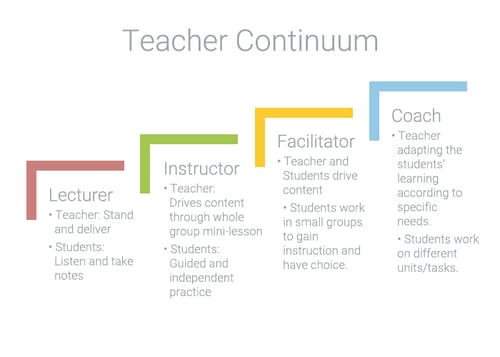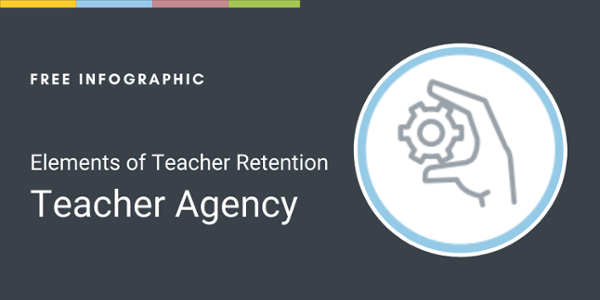During the last 100 years in the workforce, we needed farmers and factory workers; which is why our classrooms replicated the workforce, designed to have a teacher at the front of the room and desks in rows.
Times have changed, and we must make shifts to the role of the teacher in order to prepare today’s students for a different workforce. To succeed, students will need a different set of skills such as creativity, communication, critical thinking, and collaboration. They will also need to be able to adapt to change, be resilient, and to work effectively in a variety of environments – which is why we need to change the traditional role of teacher-as-expert standing and delivering content from the front of the room to a facilitator who designs customized approaches for students.
In order to help teachers make shifts, we must first evaluate where they are on the teacher continuum. Once we identify where they are, it is easier to help make small changes to their practice in order to shift to a facilitator who designs customized approaches for students. The Core Four of Personalized Learning white paper from Education Elements identifies four essential components for personalized learning classrooms, which we use as a base for how to shift the role of the teacher.
Related Resource: Learn how to create an environment of innovative leadership in your school or district, from teachers, to coaches, school and district administrators
How to Move a Teacher from Lecturer to Instructor
When you coach a teacher to move from being a lecturer to an instructor, consider starting with targeted instruction. With targeted instruction, teachers can align instruction to specific student needs and learning goals. A great way to start is to help teachers develop mini-lessons that are no longer than 10-15 minutes. This will free up the rest of the instructional block for workshop time where students can apply what they have learned in a deeper way and allow the teacher to meet with a small group or 1-1 with students.
How to Move a Teacher from Instructor to Facilitator
As you coach a teacher to move to the facilitator level, one approach is to incorporate an instructional model; here are some examples for elementary classroom and secondary classroom instructional models.
An easy entry point to start with is a station rotation model as it allows the teacher to teach mini-lessons to small groups versus the whole class, freeing up their time to meet with more students based on their needs. (*Note station rotation model is different than stations! Stations are where each student rotates through and are learning and practicing the same skills. Station rotation is when the students are going to the same 'station' but are doing work based on the skills they need.)
Deeper Dive: Learn about Teacher Retention and Happiness, and how to empower teachers as innovative leaders in classrooms and schools
How to Move a Teacher from Facilitator to Coach
In a facilitator’s classroom, students have a voice in shaping ideas, approaches, actions, and timelines within parameters (e.g., checkpoints, evaluative criteria). To develop a teacher into a coach, start by making sure all four core components are in place:
- Targeted Instruction
- Data Driven Decisions
- Flexible Content and Tools
- Student Ownership and Reflection
Use this Core Four Continuum of Personalized Learning as a guide to see what area of focus the teacher can utilize to make another shift in their teaching practice.
Many teachers who have been engaged in growing personalized learning tell us making this shift in their role brings them back to why they became a teacher — to have an impact on student learning. We would love to hear how you have made the shift in transforming your teaching or how you have coached teachers to make the shift. Share with us on Twitter: @edelements and @edu_thompson!
Looking for more ways to support teacher growth in your school or district? Learn more about the 8 Design Elements of Teacher Retention.






